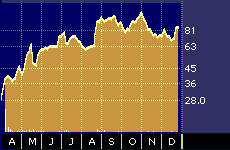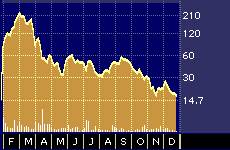
IPO Recovery Possible Next Year
IPO Recovery Possible Next Year
By Hal Plotkin
CNBC.com Silicon Valley Correspondent
Jan 2, 2001 08:30 AM

Krispy Kreme post-IPO stock price
In a year that began with investors salivating over the next skyrocketing initial public offering by a hot Internet or telecom company, it is interesting to note that it was the purveyor of an addictive fried confection, Krispy Kreme Doughnuts Inc., {KREM}, that chalked up one the biggest post-IPO gains in 2000. Kreme exited the year up 233%. And those tech IPOs? Most of them got the doughnut hole.
At least 47 of last year’s IPOs, or 12% of the total, ended 2000 90% or more below their first day close.
Just three IPOs, Embarcadero Technologies Inc. {EMBT}, First Horizon Pharmaceutical Corporation {FHRX}, and Sonus Networks Inc., {SONS} fared better than Krispy Kreme in 2000. They were up 320%, 285% and 252%, respectively.
“We’ve gone through the best of times and the worst of times in the IPO market this year,” says Richard Peterson, IPO analyst at Securities Data, based in New York. “You can make the argument that Wall Street has learned its lesson, though, which means we could see better deals next year.”

724 Solutions post-IPO stock price
The IPO market started out strong early last year, buoyed by the NASDAQ’s stunning year-end rise in 1999. 724 Solutions Inc, {SVNX}, for example, a firm that provides wireless data processing solutions for banks, rocketed up more than 175% on its opening day on Jan. 27, 2000 and then quickly climbed to $240 a share.
But the bloom started to come off the technology IPO rose a few weeks later when the broader market started faltering on concerns that the market had come too far too fast. And, an uncomfortable new question began to arise: Shouldn’t companies at least indicate a possibility of profits before they take money from the investing public?
Soon, there began a steady decline in first-day IPO gains. In the first quarter, for example, the average IPO gained 95% on its first day of trading. That dropped to a 36% gain during the second quarter, was up from there slightly to 43% for the third quarter, and then cratered at 15% during the most recent quarter, according to IPO Monitor.
| 1999 | 2000 | |
| Number of Deals | 467 | 422 |
| Avg. Amt. Raised | $133M | $230M |
| Total Amt. Raised | $62B | $97B |
| Avg. % Change | +199% | -27% |
|
Source: IPO Monitor |
||
More telling, however, is what happened to those stocks after their first day of trading. By year-end, roughly two thirds of all of last year’s IPOs were trading at or under their offering prices, according to Securities Data Inc. Just 20 of this year’s 422 IPOs have managed to hold on to a gain of 100% or more.
The increase in total dollars raised this year is attributable to 16 mega-IPOs that raked in more than a $1 billion dollars each. The IPO for AT&T’s Wireless Group {AWE}, for example, took in $10.6 billion dollars alone.
If the past is prologue, however, the bad news on the returns side could signal a revival of the IPO market sometime this year.
The major investment banks that take companies public are already in full retreat, having withdrawn or shelved more than 230 IPOs over the past 12 months. Many of those deals may never get done, analysts say, as the investment banks move on to other vehicles to keep underwriting fees and commissions coming in.
The investment banks can’t afford to get too sentimental about last year’s stalled offerings.They derive about 35% of their income from underwriting IPOs, according to Securities Data Inc. That means the pressure will be on over the coming year to bring higher-quality offerings to market. That’s not so great for the entrepreneurs who were looking for public funds. But it may be much better for the public, which will not be exposed to some of the riskiest projects in the 2000 pipeline.
There is some precedent for this in the past, with down-performing IPO years often followed by a renewed focus on quality that leads to better returns. In 1990, for example, 57% of all IPOs ended the year below their offering prices. That number fell to 21% the following year. Ditto in 1998, when 51% of offerings ended the year lower, leading to 1999 when just 22% ended the year lower.
“After a year like this the IPO market usually recovers,” says Peterson, of Securities Data Inc. “The investment banks respond to the market, and they know they need to put better deals out.”
So where will this year’s winning IPOs come from?
Look to medical services, biotechnology, oil, gas and energy generation and transmission markets, says Peterson, who notes that IPO fever tends to be driven by news events. The looming energy shortage, for example, has left underwriters scrambling to bring new energy-related issues to market.
Shares of ATP Oil and Gas Corporation (proposed ticker: ATPG), for example, are slated to hit the market in late January, while Williams Energy Partners LP (proposed ticker: WEG) has also filed for an IPO during the first quarter of 2001.
There’s also talk of a possible Kraft spinoff from Philip Morris Companies {MO} sometime this year, which analysts say could be a blockbuster, although no filings have yet been made.
Ironically, however, analysts say that one of the most successful IPOs over the next few months is likely to be Peet’s Coffee and Tea Inc. (proposed ticker: PEET), which would give consumers something to drink with all those Krispy Kreme doughnuts.
Peet’s, a fashionable high-end coffee retailer with a devoted following, plans to use the IPO proceeds to open new outlets.
“Given how Krispy Kreme did, I wouldn’t be at all surprised to see that one also do very well,” says Peterson.
The need for coffee, he says, is something investors will likely understand.


